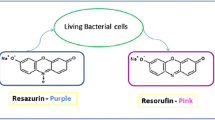Abstract
Candida albicans strain B 311-10 with and without starvation was cultivated in the minimal synthetic medium of Shepherd et al. [18], modified without biotin, aminoacids, low glucose concentration [20] and with decreasing amounts of (NH4)2SO4, to determine the optimal growth requirement for this strain. All the experiments were carried out under sterile conditions at 25 °C in a thermostat with initial O.D.s (675 nm) of 0.500 and 0.100. Cell growth was generally monitored everyday for six days with a spectrophotometer by determining the absorbance of the cultures at 675 nm. All the experiments were repeated three times and a statistical analysis of the data with a probability of 99% and 1% of error was performed to confirm the validity of the results. Best growth was obtained with starved cells at an initial O.D. of 0.100 and with a 0.1 g/L concentration of (NH4)2SO4. At this concentration, the growth of C. albicans B 311-10 was best between the first and the fourth day with the maximum at the third day. With (NH4)2SO4 concentrations of 0.05 and 0.5 g/L, cell growth was the same.
Similar content being viewed by others
References
Behálova B, Votruba J. Fed-batch cultivation of Saccharomyces cerevisiae with increased content of Δ5.7 sterols. Folia Microbiologica 1986; 31: 129–137.
Cannon RD. Isolation of a mycelial mutant of Candida albicans. J Gen Microbiol 1986; 132: 2405–2407.
Egli TH, Quayle JR. Influence of the carbon: nitrogen ratio on the growth, on the cellular composition and the ability of the methylotrophic yeast Hansenula polymorpha to utilize mixed carbon sources. J Gen Microbiol 1986; 132: 1779–1788.
Evans EGV, Odds FC, Richardson MD, Holland KT. The effect of growth medium on filament production in Candida albicans. Sabouraudia 1974; 12: 112–119.
Franco CMM, Smith JE, Berry DR. Effect of nitrogen and phosphate on the levels of intermediates in bakers' yeast grown in continuous culture. J Gen Microbiol 1984; 130: 2465–2472.
Kole MM, Thompson BG, Gerson DF. Ammonium concentration control in fed-batch fermentations of Saccharomyces cerevisiae. J Ferment Technol 1985; 63: 121–125.
Kreger-van Rij NJW. The yeasts: A taxonomic study. Amsterdam: Elsevier, 1984.
Land GA, McDonald WC, Stjernholm RL, Friedman L. Factors affecting respiration in Candida albicans during filamentation. Inf Imm 1975 12: 119–127.
Lee KL, Buckley HR, Campbell C. An aminoacid liquid synthetic medium for development of mycelial and yeast forms of Candida albicans. Sabouraudia 1975; 13: 148–153.
Lloyd D, Bodil K, Degn H. Glycolisis and respiration in yeasts: the effect of ammonium ions studied by mass spectrometry. J Gen Microbiol 1983; 129: 2125–2127.
Morton AG, MacMillan A. The assimilation of nitrogen from ammonium salts and nitrate by fungi. J Exp Bot 1954; 5: 232–252.
Park D. Inorganic nitrogen nutrition and yeast-mycelial dimorphism in Aureobasidium pullulans. Trans Br Mycol Soc 1982; 78: 385–388.
Park D. Population density and yeast-mycelial dimorphism in Aureobasidium pullulans. Trans Br Mycol Soc 1984; 82: 39–44.
Park D. Low pH and the development of large cells in Aureobasidium pullulans. Trans Br Mycol Soc 1984; 82: 717–720.
Peña A, Pardo JP, Ramirez J. Early metabolic effects and mechanism of ammonium transport in yeast. Arch Biochem Biophys 1987; 253: 431–438.
Piñon R. Effects of ammonium ions on sporulation of Saccharomyces cerevisiae. Exp Cell Res 1977; 105: 367–378.
Pollack JH, Hasimoto T. The role of glucose in the pH regulation of germ-tube formation in Candida albicans. J Gen Microbiol 1987; 133: 415–424.
Shepherd MG, Chew Yoke Yin, Ram SP, Sullivan PA. Germ-tube induction in Candida albicans. Can J Microbiol 1980; 26: 21–26.
Thevelein JM, Beullens M. Cyclic AMP and the stimulation of threalase activity in the yeast Saccharomyces cerevisiae by carbon sources, nitrogen sources and inhibitors of protein synthesis. J Gen Microbiol 1985; 131: 3199–3209.
Vidotto V, Pugliese A, Gioannini P. Growth of Candida albicans in a minimal synthetic medium without biotin. Mycopathologia 1987; 100: 7–15.
Author information
Authors and Affiliations
Rights and permissions
About this article
Cite this article
Vidotto, V., Ochoa, L.G., Cortes, J.M. et al. Optimal concentration of ammonium ion in a minimal synthetic medium for the growth of Candida albicans . Mycopathologia 113, 139–142 (1991). https://doi.org/10.1007/BF00436116
Received:
Accepted:
Issue Date:
DOI: https://doi.org/10.1007/BF00436116




